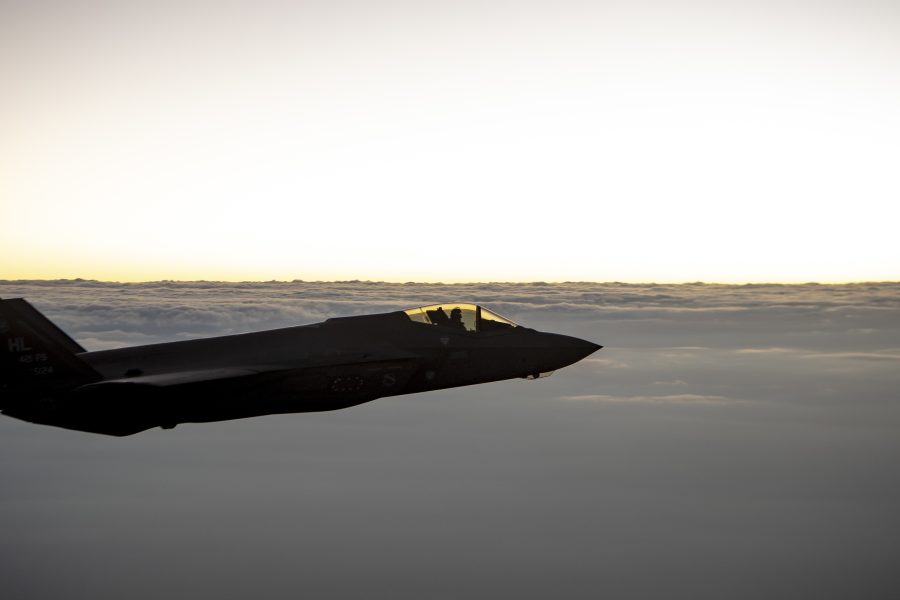The U.S. is deploying F-35 fifth-generation fighters and additional F-16s to the U.S. Central Command region, the Pentagon announced July 17.
The Department of Defense is also authorizing the deployment of an additional guided missile destroyer in response to “an alarming number of recent events in the Strait of Hormuz,” deputy Pentagon press secretary Sabrina Singh told reporters. Earlier this month, Iran sought to seize two commercial oil tankers and fired on one of them before abandoning the attempt when an American guided missile destroyer, the USS McFaul, arrived on the scene.
Iran is not the only threat in the region. The U.S. and Russia have had close calls in the skies in recent months, both over western Syria with Russian aircraft harassing American MQ-9 Reapers, and with manned Russian aircraft flying near manned American fighters and U.S. troops in eastern Syria.
A senior U.S. defense official told Air & Space Forces Magazine that the F-35s could be used over the Gulf and the Strait of Hormuz if the airspace became contested and could be used over Syria if Russia presented a more significant threat.
The Strait of Hormuz is a choke point between the Persian Gulf and the Gulf of Oman, through which roughly 20 percent of the world’s oil supply flows. To deter Iran, the U.S. has A-10s and F-16s patrolling the skies in the area, in addition to P-8 Poseidon maritime patrol aircraft. Another destroyer, the USS Thomas Hudner, will now join the U.S. maritime force in the region.
“In light of this continued threat and in coordination with our partners and allies, the department is increasing our presence and ability to monitor the Strait and surrounding waters,” Singh said.
Singh said Secretary of Defense Lloyd J. Austin III consulted with the commander of U.S. Central Command, Army Gen. Michael “Erik” Kurilla, and decided to send “assets to the region that they felt it was important to do at this time.”
“It’s just an additional asset to help,” Singh said of the F-35 deployment. “We’ve seen Iran continue to engage in destabilizing activity.”
A-10s are most useful in uncontested airspace, which is why the Air Force wants to retire them by the end of the decade, figuring they are not suited to a high-end fight. Iran has fighter aircraft such as American-made F-4 Phantoms and surface-to-air missiles along its coast that can reach out over the Strait of Hormuz, where Iran previously downed a U.S. RQ-4 drone in 2019. F-22 Raptors that were rushed to the region last month in response to Russian actions are leaving CENTCOM, according to U.S. officials.
“If the maritime domain becomes contested, the F-35s would be able to operate and conduct that mission,” the senior U.S. defense official told Air & Space Forces Magazine.
While the senior U.S. defense official said they didn’t anticipate Tehran would seek to challenge the U.S. in the skies, the F-35s would be well suited to respond.
“They could suppress the enemy defenses if you got to that level,” the official said. “If F-4s start flying out to harass the A-10s, we could fly F-35s out there and the F-4 is not really going to be a particular issue.”
Despite a reduced permanent U.S. presence in the region, the DOD has been forced to bulk up its force in the Middle East on short notice in response to threats from Iran and Russia multiple times in the past year.
“We have the capability present where we need it,” Lt. Gen. Douglas A. Sims II, the director for operations for the Joint Staff, said July 13 when asked if the U.S. would need to increase its force in the region in response to Russian actions over Syria. “I believe that the combatant commander—in this case, in the Central Command—has all the necessary assets if there was an issue.”
U.S. MQ-9 drones have been harassed by Russian planes over western Syria this past month. Since March 1, Russian aircraft have regularly overflown U.S. troops in eastern Syria and have flown within 500 feet of American manned aircraft, actions which Air Forces Central commander Lt. Gen. Alexus G. Grynkewich has repeatedly called out as “unsafe and unprofessional.” The U.S. has roughly 900 troops in Syria and partners with Kurdish groups to defeat the remnants of ISIS. U.S. aircraft support the effort by providing intelligence, surveillance, and reconnaissance, force protection, and airstrikes. Meanwhile, Russia is in Syria supporting the regime of Bashar Al-Assad.
The A-10s were the first Air Force assets to fly maritime missions in response to recent Iranian actions, before being bolstered by F-16s, which are faster and have a greater ability to conduct counterair missions, in the last few days. F-35s will add additional fighter capacity and counterair capability, both in the Gulf and over the skies of Syria.
“It’s a stealthy fifth-gen platform with advanced avionics and sensor suite,” the senior U.S. defense official told Air & Space Forces Magazine. “It’s very useful in a contested environment.”


